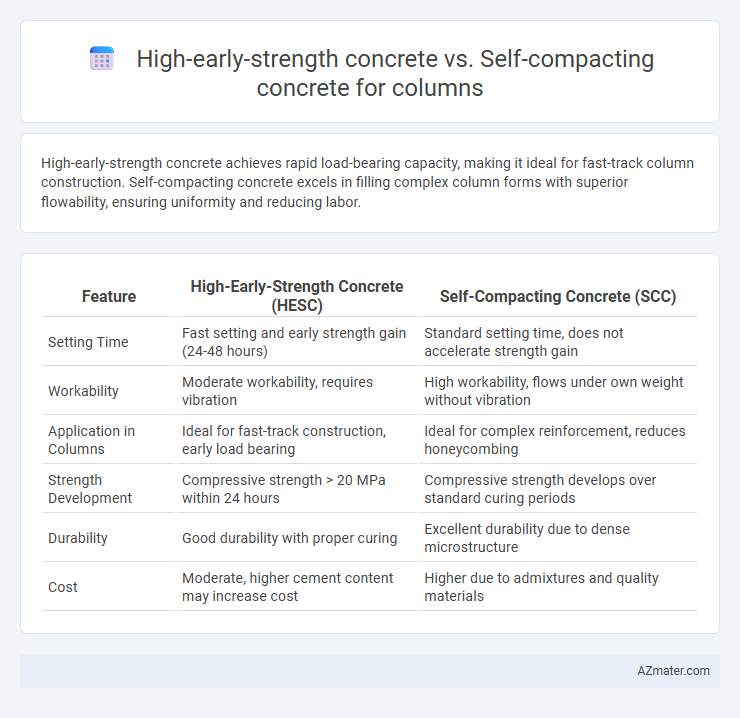High-early-strength concrete achieves rapid load-bearing capacity, making it ideal for fast-track column construction. Self-compacting concrete excels in filling complex column forms with superior flowability, ensuring uniformity and reducing labor.
Table of Comparison
| Feature | High-Early-Strength Concrete (HESC) | Self-Compacting Concrete (SCC) |
|---|---|---|
| Setting Time | Fast setting and early strength gain (24-48 hours) | Standard setting time, does not accelerate strength gain |
| Workability | Moderate workability, requires vibration | High workability, flows under own weight without vibration |
| Application in Columns | Ideal for fast-track construction, early load bearing | Ideal for complex reinforcement, reduces honeycombing |
| Strength Development | Compressive strength > 20 MPa within 24 hours | Compressive strength develops over standard curing periods |
| Durability | Good durability with proper curing | Excellent durability due to dense microstructure |
| Cost | Moderate, higher cement content may increase cost | Higher due to admixtures and quality materials |
Introduction to Column Concrete Solutions
High-early-strength concrete offers rapid strength gain, enabling faster formwork removal and early load application, ideal for speeding up column construction schedules. Self-compacting concrete provides superior flowability and filling ability, ensuring uniform consolidation in complex column forms without vibration, enhancing structural integrity and surface finish. Choosing between these solutions depends on project timelines and structural requirements for optimized column performance.
Defining High-Early-Strength Concrete (HESC)
High-early-strength concrete (HESC) is engineered to achieve rapid strength gain, often reaching 70% of its ultimate strength within 24 hours, making it ideal for accelerating construction schedules in column projects. It features a high cement content with finely ground materials and chemical accelerators to promote early hydration, ensuring adequate load-bearing capacity shortly after casting. This rapid strength development distinguishes HESC from self-compacting concrete, which prioritizes flowability and ease of placement over early strength.
Understanding Self-Compacting Concrete (SCC)
Self-Compacting Concrete (SCC) is designed to flow effortlessly into complex column molds without the need for mechanical vibration, ensuring uniform compaction and superior surface finish. Unlike High-Early-Strength Concrete, which prioritizes rapid strength gain for early load application, SCC focuses on enhanced workability and durability, minimizing labor and reducing voids in dense reinforcement areas. Understanding SCC's rheological properties is essential for optimizing column construction where intricate formwork and congestion present significant challenges.
Key Properties of HESC for Columns
High-early-strength concrete (HESC) for columns offers rapid strength gain, reaching up to 70% of its design strength within 24 hours, which accelerates construction schedules and formwork removal. It possesses enhanced compressive strength typically ranging from 30 to 60 MPa at early ages, combined with low permeability that ensures durability and resistance to environmental attacks. The high cement content and optimized mix design in HESC reduce shrinkage and improve load-bearing capacity, making it ideal for columns subjected to early loading conditions.
Key Properties of SCC for Columns
Self-compacting concrete (SCC) offers superior flowability and segregation resistance, enabling it to fill complex column forms without mechanical vibration, ensuring uniform density and surface finish. Key properties of SCC for columns include high deformability, stability against segregation, and adequate strength development to support structural loads, which reduces labor costs and enhances construction speed compared to high-early-strength concrete. SCC's rheological properties improve placement efficiency in congested reinforcement environments, making it ideal for vertical members requiring consistent quality and durability.
Workability and Placement Efficiency
High-early-strength concrete offers rapid setting and high initial strength, enabling quicker formwork removal and early load application in columns, but it often requires careful vibration and compaction to avoid voids. Self-compacting concrete enhances workability by flowing under its own weight without vibration, ensuring uniform filling and encapsulation of reinforcement within columns, significantly improving placement efficiency in complex or congested formworks. Comparing both, self-compacting concrete excels in placement speed and surface quality, while high-early-strength concrete is preferred where rapid strength gain is critical.
Structural Performance Comparison
High-early-strength concrete achieves rapid strength gain, enabling faster formwork removal and load application, which is crucial for time-sensitive column construction. Self-compacting concrete optimizes structural performance through superior flowability, reducing voids and enhancing uniformity and bond strength within columns. While high-early-strength concrete excels in early load-bearing capacity, self-compacting concrete offers improved durability and surface quality, directly influencing long-term structural integrity.
Durability and Long-Term Behavior
High-early-strength concrete achieves rapid strength gain, ensuring early load application but may exhibit higher shrinkage and potential microcracking affecting long-term durability. Self-compacting concrete offers superior homogeneity and reduced voids around reinforcement, enhancing durability by minimizing permeability and improving corrosion resistance of steel in columns. Long-term behavior favors self-compacting concrete for sustained performance, whereas high-early-strength concrete may require additional curing measures to mitigate durability risks.
Cost Implications and Economic Considerations
High-early-strength concrete offers accelerated curing times, reducing formwork and labor costs in column construction but often comes with higher material expenses due to specialized cement blends. Self-compacting concrete minimizes labor costs and enhances structural quality by flowing into complex column molds without vibration, yet its admixtures and mix design can increase upfront costs. Evaluating economic considerations involves balancing initial material investments with potential savings from reduced labor and construction time efficiency for optimized column construction budgets.
Application Scenarios and Final Recommendations
High-early-strength concrete is ideal for columns requiring rapid load-bearing capacity, such as in fast-track construction or repair works where minimizing downtime is critical. Self-compacting concrete suits complex column geometries and heavily reinforced sections, ensuring uniform compaction without vibration and superior surface finish. For projects demanding swift strength gain, prioritize high-early-strength concrete; for intricate formworks or labor-saving benefits, self-compacting concrete is the optimal choice.

Infographic: High-early-strength concrete vs Self-compacting concrete for Column
 azmater.com
azmater.com